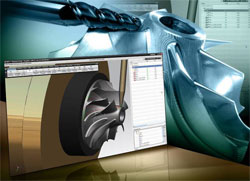Product Lifecycle Management for Machine Tools

The portfolio extends from computer-aided product development at the CAD/CAM level up to virtual machines, and considerably shortens time-to-market for machine builders while also enhancing product quality and productivity for end user customers.
The software portfolio of the Siemens presentation at this year's EMO focuses on the workpieceoriented process chain between the initial idea for the product and the finished part.
The software fully covers the requirements for sophisticated product lifecycle management tasks in the machine tool industry. This begins with product development using CAD/CAM systems and the generation of programs for parts, via optimization of the post processor and the CNC parameters and extends to offline simulations for validating and optimizing the manufacturing process.
NX software from Siemens provides an open and versatile 3D system at the CAD/CAM/CAE level for the entire design and manufacturing process. NX facilitates the construction of full 3D models using the latest technology for fast and easy model creation and editing. Specifications defined during the design phase such as manufacturing tolerances and finish are attached to the 3D CAD models as Product and Manufacturing Information (PMI). The full 3D geometric model and the attached data such as PMI is available later in the process for manufacturing engineering and can be used directly in NX CAM to drive NC programming selections.
NX CAM includes NX Post Builder an application which makes it easy to create a post-processor exactly suited to a customer’s machine tool and specifically prepared for SINUMERIK controllers.
The tightly connected NX post processor automatically adjusts the part program based on machine operations such as roughing, semi-finishing and finishing and related machining data inside NX CAM. To that end Siemens PLM Software has introduced a range of new functions in NX CAM including a set of menu options available to the NC programmer to allow these special options that drive key elements of the advanced functions on Siemens’ Sinumerik controller to be selected during NC programming.
Another important element of the workpiece-oriented process chain is the “Virtual Machine” software package for machine tools with Sinumerik CNC controllers. This includes a version of the software from the real controller, (known as the virtual Numeric Control Kernel – VNCK), the machining simulation system (RealNC) for 3D model based simulation with gouge and collision detection, as well as the original Sinumerik HMI software for operating the virtual controller and machine. The Virtual Machine simulation facilitates extremely realistic simulation on a standard PC of the NC machining processes. This level of simulation can be used to effectively eliminate programming errors and possible collisions. Job changeover times are considerably shortened as a result of thorough validation and set-up checking on the virtual machine. By more efficient programming, shorter changeover times and reducing the error risk, simulation of the production processes with the “Virtual Machine” software system helps to optimize manufacturing processes and thus raise productivity.
The Siemens Industry Sector (Erlangen, Germany) is the worldwide leading supplier of production, transportation, building and lighting technologies. With integrated automation technologies as well as comprehensive industry-specific solutions, Siemens increases the productivity, efficiency and flexibility of its customers in the fields of industry and infrastructure. The Sector consists of six Divisions: Building Technologies, Drive Technologies, Industry Automation, Industry Solutions, Mobility and Osram. With around 222,000 employees worldwide Siemens Industry achieved in fiscal 2008 a profit of EUR3.86 billion with revenues totaling EUR38 billion.
The Siemens Drive Technologies Division (Nuremberg, Germany) is the world's leading supplier of products and services for production machinery and machine tools. Drive Technologies offers integrated technologies that cover the entire drive train with electrical and mechanical components. This includes standard products but also encompasses industry-specific control and drive solutions for metal forming, printing and electronic manufacturing as well as solutions for glass, wood, plastic, ceramic, textile and packaging equipment and crane systems. The services provided by the Division include mechatronics support in addition to online services for web-based fault management and preventive maintenance. With around 39,900 employees worldwide Siemens Drive Technologies achieved in fiscal 2008 total sales of EUR8.9 billion.
Media Contact
All latest news from the category: Machine Engineering
Machine engineering is one of Germany’s key industries. The importance of this segment has led to the creation of new university degree programs in fields such as production and logistics, process engineering, vehicle/automotive engineering, production engineering and aerospace engineering among others.
innovations-report offers informative reports and articles covering technologies such as automation, motion, power train, energy, conveyor, plastics, lightweight construction, logistics/warehousing, measurement systems, machine tools and control engineering.
Newest articles

Making diamonds at ambient pressure
Scientists develop novel liquid metal alloy system to synthesize diamond under moderate conditions. Did you know that 99% of synthetic diamonds are currently produced using high-pressure and high-temperature (HPHT) methods?[2]…

Eruption of mega-magnetic star lights up nearby galaxy
Thanks to ESA satellites, an international team including UNIGE researchers has detected a giant eruption coming from a magnetar, an extremely magnetic neutron star. While ESA’s satellite INTEGRAL was observing…

Solving the riddle of the sphingolipids in coronary artery disease
Weill Cornell Medicine investigators have uncovered a way to unleash in blood vessels the protective effects of a type of fat-related molecule known as a sphingolipid, suggesting a promising new…





















